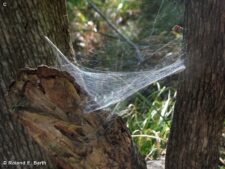
This spider cannot be identified from these images down to below genus, according to the volunteer experts at BugGuide. Microscopic analysis is required to examine the male pedipalps – the dark key-like feature in (B) – to determine the species. These spiders construct elaborate sheet webs, with a funnel in which the spider waits until an insect falls onto the non-sticky web and gets entangled. The sheet web in image (C) is unusually high off the ground. Normally they are up against a fallen log or among fallen branches. These spiders are lightning fast and can quickly catch, bite and retrieve what gets caught.
These spiders are very common at both nature centers in the fall, especially on dry woodland ridges, where the sheet webs can be seen when dew collects on their nets. Although they can be seen lurking in their funnels, they quickly retreat when being approached. They live only one season long, usually until the first frost. Their eggs overwinter in an egg sac hidden in a crevice.
Disclaimer: The content of NatureSearch is provided by dedicated volunteer Naturalists of Fontenelle Forest who strive to provide the most accurate information available. Contributors of the images retain their copyrights. The point of contact for this page is: Roland Barth.


